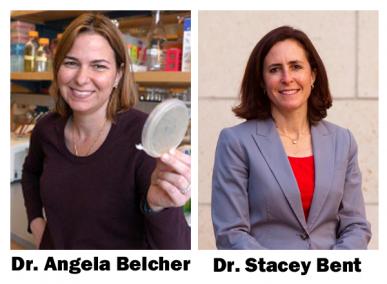 This is the second in a series of posts about leading women in the power, environmental science, advocacy, policy, and business sectors. To see previous installments, please use the ‘Search’ field in the left sidebar to search for ‘Women in Power.’
This is the second in a series of posts about leading women in the power, environmental science, advocacy, policy, and business sectors. To see previous installments, please use the ‘Search’ field in the left sidebar to search for ‘Women in Power.’
Today, women earn roughly half of the bachelor’s degrees in the earth and biological sciences, but only about 20 percent of the degrees in physics and engineering. And as women’s careers continue to develop—through higher degrees and into professional positions—these numbers start small and only get smaller. Despite the tremendous educational and professional gains women have made in the past 50 years, progress has been uneven, and many scientific and engineering fields remain overwhelmingly male-dominated. The so-called “leaky pipeline” is a real issue. However, highly accomplished women in science and engineering do exist, and they are making huge differences in the way we make and manage clean energy.
I had the opportunity to sit down with two awe-inspiring female scientists who truly define “cutting edge” when it comes to the critical technologies we need to transition away from dirty fossil fuels. Dr. Stacey Bent, Professor of Engineering at Stanford University, and Dr. Angela Belcher, Professor of Biological Engineering at MIT, are both exploring the frontier of materials science, a critical area of study leading to advancements in renewable energy and energy storage.
 Dr. Stacey Bent’s work has focused on the fundamental understanding of how different materials behave, or more specifically, how molecules react with certain surfaces. As Dr. Bent noted, “this is essential to making semiconductor devices used in computer chips and solar panels for example.” And with her understanding of surface science and materials chemistry, she is pushing innovation forward and making these technologies more efficient at the same time.
Dr. Stacey Bent’s work has focused on the fundamental understanding of how different materials behave, or more specifically, how molecules react with certain surfaces. As Dr. Bent noted, “this is essential to making semiconductor devices used in computer chips and solar panels for example.” And with her understanding of surface science and materials chemistry, she is pushing innovation forward and making these technologies more efficient at the same time.
Dr. Angela Belcher, named TIME magazine’s Climate Change Hero in 2007, has pioneered a biomimicry technique which allows her to use the precision of nature as a blueprint for engineering inorganic materials. Lucky for the cleantech world, with this technique Dr. Belcher is creating an entirely new kind of battery, not by building it, but by growing it.
Both women were fueled at a young age by a passion for basic science- how molecules behave, the origins of life, basic chemistry and biology- and both attribute their movement into the clean energy world not just to their fundamental interest in applying science for the benefit of humanity, but in large part to their students. Dr. Belcher assured me that,
You can’t get an MIT student to do things they don’t want to do, and my students come to my lab so passionate about energy and clean technology.
Dr. Bent similarly finds inspiration from the “phenomenal interest at the student level to have an impact” on climate change.
Yet, with all the enthusiasm around these fields, according to Dr. Bent, she realized only after she had completed her own college education that, “I never once had a female professor.” When not spending time with her children and developing new materials for renewable energy devices or next generation microelectronics, she says she’s thought a lot about the question of women in science and engineering.
There has been a progression, but it’s been really slow. The ratio of women to men, particularly in non-biological fields, seems to be creeping up very slowly, especially the higher you go.
Now, between her own research group and roles as Director of the TomKat Center for Sustainable Energy at Stanford University and Co-Director of a Department of Energy’s Energy Frontier Research Center, Dr. Bent says she takes her advising roles, whether formal or informal, very seriously. “Having good teachers is so key to a student’s trajectory,” and her motivation to solve problems is certainly contagious.
Dr. Belcher clearly agrees, and recalls that one of her proudest moments was the day two of her female graduate students showed her a petri dish with some spots in it. These were not just spots, she helpfully explained, but actually clones that contained a genetic sequence directly related to the output of a battery. This material could be engineered to optimize the performance of a battery, and by using biology to do so, they were also minimizing the energy intensity and toxicity of this process. Looking up at a picture on her office wall of those two grad students holding the battery, she recounted the story of watching President Obama give a speech on clean energy with their battery glowing in the background. “Second to when my boys were born, it was the best day of my life,” she explained.
Thanks to the brilliance, diligence, and sheer curiosity of scientists and engineers like Dr. Bent and Dr. Belcher, we are seeing major breakthroughs in cleantech. They offer important reminders that before a solar panel is mounted, a wind turbine erected, or a chic electric car driven off the lot, someone can be found in a lab creating, experimenting, and innovating with all the basic materials these technologies require.
Both Dr. Bent and Dr. Belcher attribute their success to having followed their passions. Both also believe it is important to bring more women into the field because without more diversity in backgrounds and perspectives, as Dr. Bent put it, “we are surely missing out on important advances we could be making.”
This commentary originally appeared on our EDF Voices blog.









